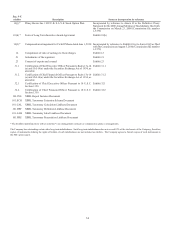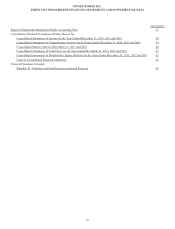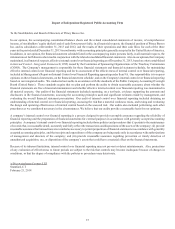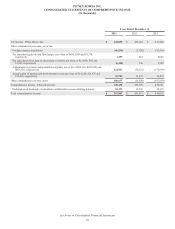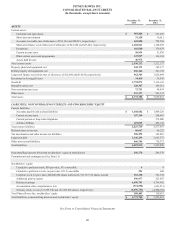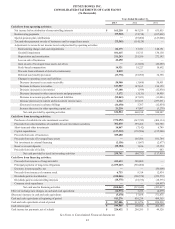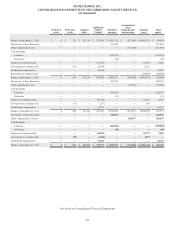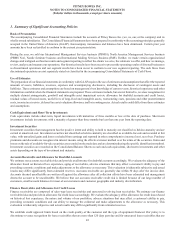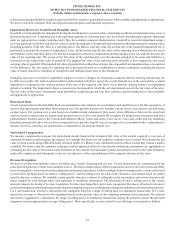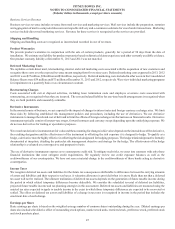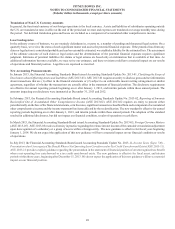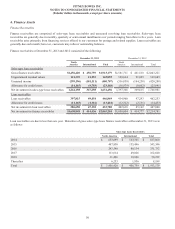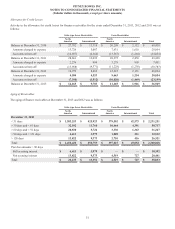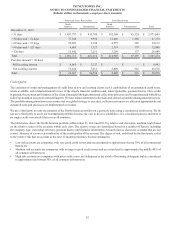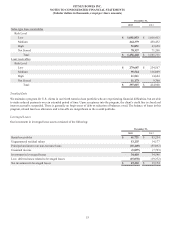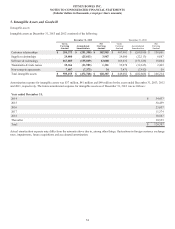Pitney Bowes 2013 Annual Report Download - page 55
Download and view the complete annual report
Please find page 55 of the 2013 Pitney Bowes annual report below. You can navigate through the pages in the report by either clicking on the pages listed below, or by using the keyword search tool below to find specific information within the annual report.PITNEY BOWES INC.
NOTES TO CONSOLIDATED FINANCIAL STATEMENTS
(Tabular dollars in thousands, except per share amounts)
44
more than 90 days past due. We resume revenue recognition when customer payments reduce the account balance aging to 60 days or
less past due. Finance receivables deemed uncollectible are written off against the allowance after all collection efforts have been exhausted
and management deems the account to be uncollectible. We believe that our finance receivable credit risk is limited because of our large
number of customers, small account balances for most of our customers and customer geographic and industry diversification.
Inventories
Inventories are stated at the lower of cost or market. Cost is determined on the last-in, first-out (LIFO) basis for most U.S. inventories
and on the first-in, first-out (FIFO) basis for most non-U.S. inventories.
Fixed Assets and Depreciation
Property, plant and equipment and rental equipment are stated at cost and depreciated principally using the straight-line method over
their estimated useful lives, which are up to 50 years for buildings, three to 15 years for machinery and equipment, four to six years for
rental equipment and three to five years for computer equipment. Major improvements which add to productive capacity or extend the
life of an asset are capitalized while repairs and maintenance are charged to expense as incurred. Leasehold improvements are amortized
over the shorter of the estimated useful life or the remaining lease term.
Fully depreciated assets are retained in fixed assets and accumulated depreciation until they are removed from service. In the case of
disposals, assets and related accumulated depreciation are removed from the accounts and the net amounts, less proceeds from disposal,
are included in earnings.
Software Development Costs
We capitalize certain costs of software developed for internal use. Capitalized costs include purchased materials and services, payroll
and personnel-related costs and interest costs. The cost of internally developed software is amortized on a straight-line basis over its
estimated useful life, principally three to 10 years.
Costs incurred for the development of software to be sold, leased or otherwise marketed are expensed as incurred until technological
feasibility has been established, at which time such costs are capitalized until the product is available for general release to the public.
Capitalized software development costs include purchased materials and services and payroll and personnel-related costs attributable to
programmers, software engineers, quality control and field certifiers. Capitalized software development costs are amortized generally on
a straight-line basis over the product's estimated useful life, principally three to five years. Software development costs capitalized were
$4 million in both 2013 and 2012. Amortization of capitalized software development costs was $8 million, $10 million and $10 million
for the years ended December 31, 2013, 2012 and 2011, respectively. At December 31, 2013 and 2012, capitalized software development
costs included in other assets were $5 million and $9 million, respectively.
Research and Development Costs
Research and product development costs, which primarily included personnel-related costs, are expensed as incurred. These costs include
engineering costs related to research and product development activities.
During 2013, we determined that certain research and development costs should have been classified as cost of software. Accordingly,
the Consolidated Statements of Income for the years ended December 31, 2012 and 2011 have been revised to reflect the correct
classification, resulting in a decrease in research and development expenses and a corresponding increase in cost of software of $23
million and $20 million, respectively. This revision did not impact previously reported total costs and expenses, net income or earnings
per share amounts and was not material to any of our previously issued financial statements.
Business Combinations
We account for business combinations using the acquisition method of accounting, which requires that the assets acquired and liabilities
assumed be recorded at the date of acquisition at their respective fair values. The fair value of intangible assets is estimated using a cost,
market or income approach. Goodwill represents the excess of the purchase price over the estimated fair values of net tangible and
intangible assets acquired. Finite-lived intangible assets are amortized over their estimated useful lives, principally three to 15 years,
using either the straight-line method or an accelerated attrition method. Operating results of acquired companies are included in the
consolidated financial statements from the date of acquisition.
Impairment Review for Long-lived Assets
Long-lived assets are reviewed for impairment whenever events or changes in circumstances indicate that the carrying amount may not
be fully recoverable. The related estimated future undiscounted cash flows expected to result from the use of the asset and its eventual
disposition is compared to the carrying amount. If the sum of the expected cash flows is less than the carrying amount, an impairment
charge is recorded for an amount by which the carrying amount exceeds the fair value of the asset. The fair value of the impaired asset


